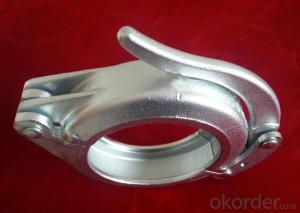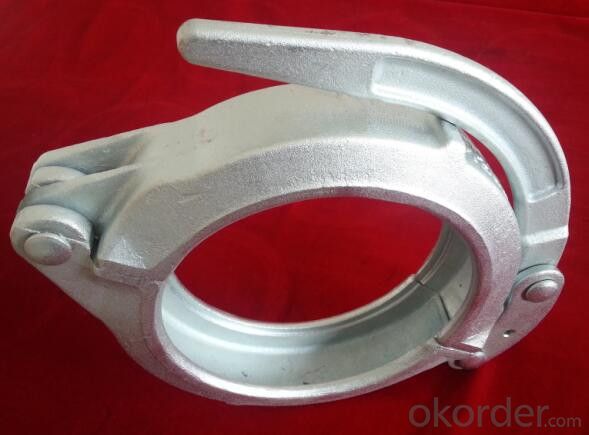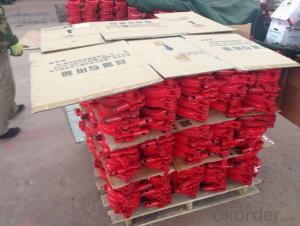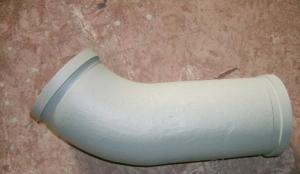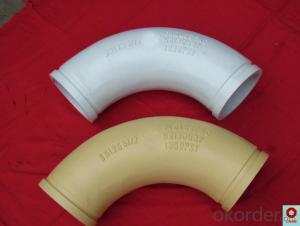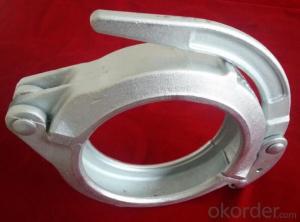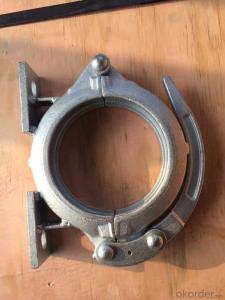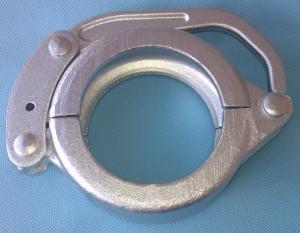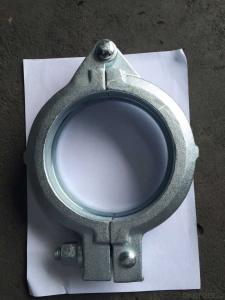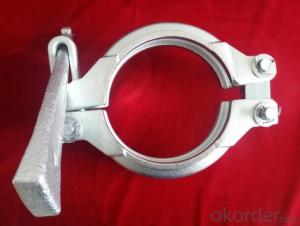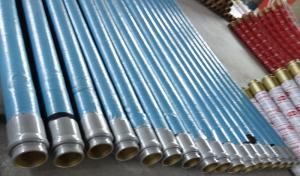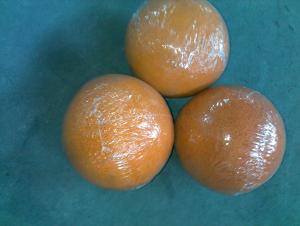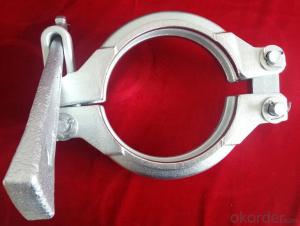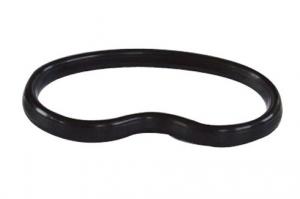Concrete Pump Clamp Coupling DN100 Forged
- Loading Port:
- China main port
- Payment Terms:
- TT OR LC
- Min Order Qty:
- 50 PCS
- Supply Capability:
- 10000 PCS/month
OKorder Service Pledge
OKorder Financial Service
You Might Also Like
Product Description:
A coupling is a device used to connect two delivery pieps together at their ends for the purpose of transmitting, and prevent the concrete from leaking. Couplings do not normally allow disconnection of shafts during operation.
Main Product Features:
1. Use high quality steel. After high-temperature 1200 forging,it’s shaped.
2.High temperature forging.
3.convenient to use, easy operation,and high safety.
4.good sealing,wear-resising,longer service life.
5.do not restrict the steering tubes, pipes during the working process can be 360 degrees rotation.
6.used in concrete pump truck,concrete pump and pipeline connection seal in construction
work equipment.
Product Specifications:
1.Forged
2.2--8 inch
3.Galvanizing/Baking varnish
4.More durable,light,beautiful
Production steps:
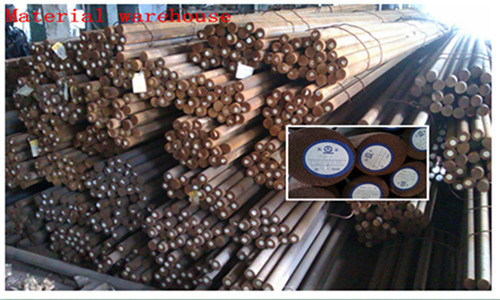
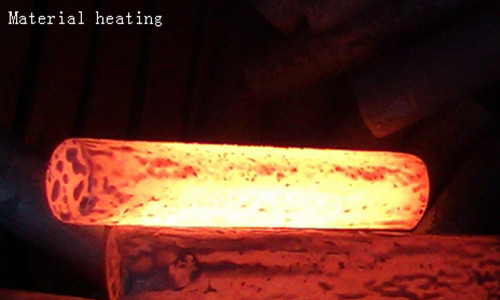
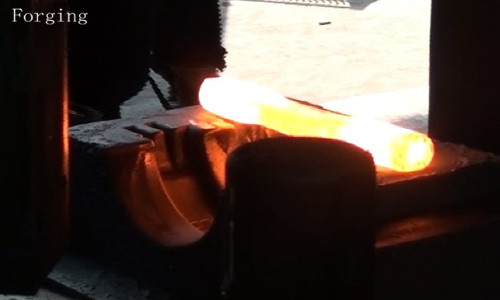

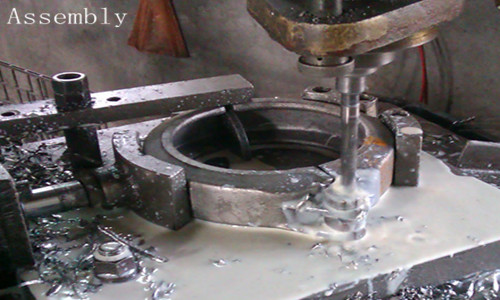
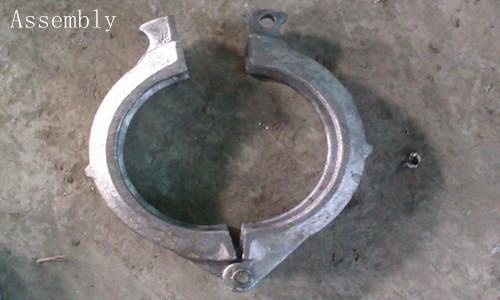
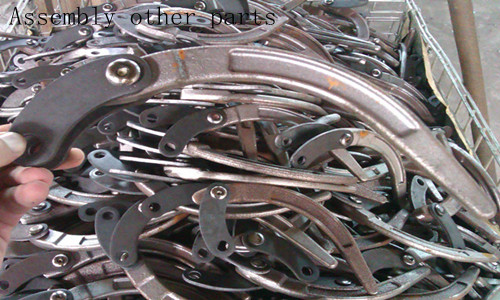
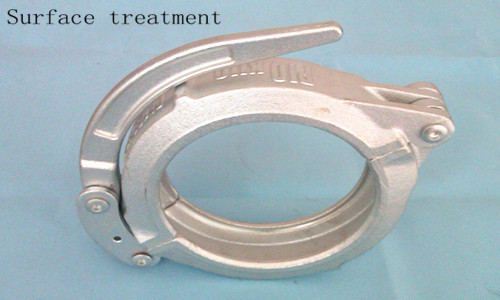
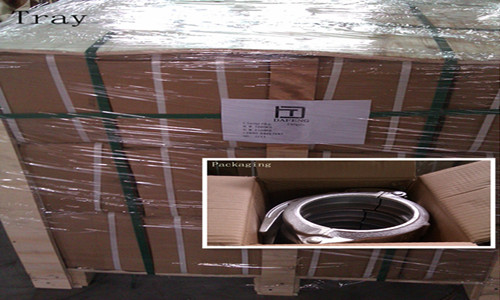
Concrete pump clamp Catalogue
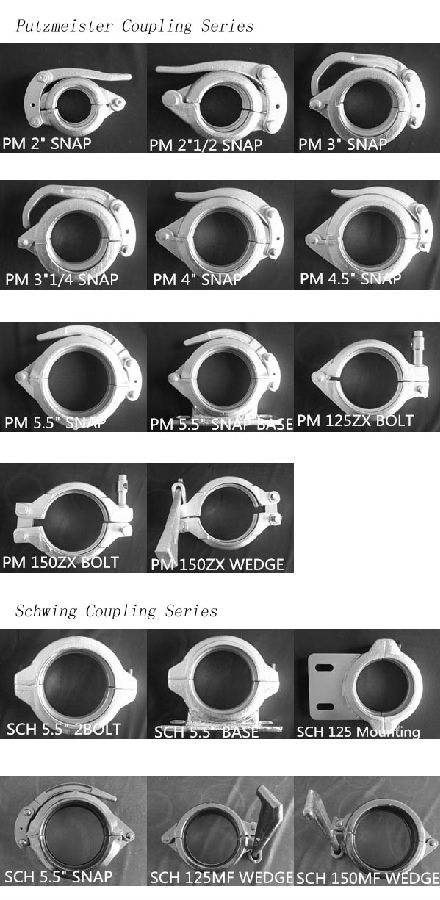
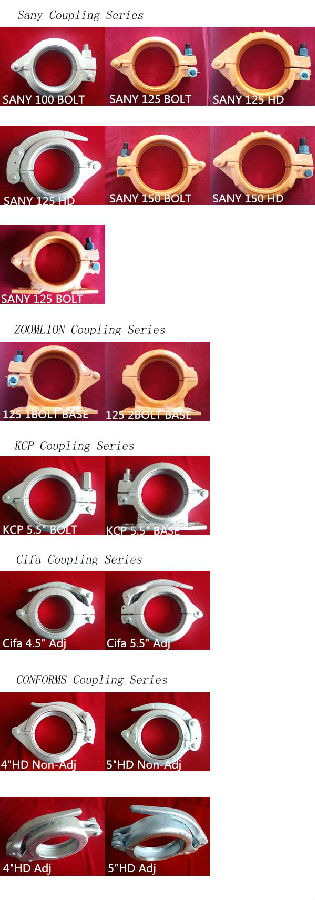
FAQ
1.How do you regarding your product quality?
As our principle is more safety to save more. In China, there are lots of manufactures of this line, but we are the first one that use the forging technic in producing, firmly meet the PM standard.
2.Can I get some samples?
Of course you can. Small sample for free, but you pay the express. For some products are not small, like concrete pump pipe, it’s very difficult to deliver one pipe of 3000mm. If it’s possible, we’d like that you can come here to visit our factory. Welcome!
3. I want to make our logo on the products, is that ok?
Yes, it’s totally ok. OME is available from us.What you should do is send your logo, brand name, or picture to us. And let other things leave on us.
- Q: How often should concrete pump control panels be inspected and replaced?
- Regular inspections should be conducted on concrete pump control panels to ensure proper functioning and detect any potential problems or malfunctions. The frequency of inspections may vary based on factors such as pump type, operating conditions, and manufacturer recommendations. However, a general rule is to thoroughly inspect the panels at least once every six months or after every 500 hours of operation, whichever comes first. Trained professionals should perform these inspections, examining control panel components like buttons, switches, indicators, and wiring for signs of wear or damage. They should also test all functions and safety features to verify the panel's functionality. When it comes to replacement, it is crucial to adhere to the manufacturer's guidelines and recommendations. Typically, control panels have a lifespan of several years, but this can vary depending on factors like panel quality, frequency of use, and maintenance practices. If significant issues or failures are identified during inspections, prompt replacement of the control panel is important to ensure safe and efficient operation of the concrete pump. Ultimately, regular inspections and timely replacement of control panels are vital to minimize the risk of equipment failure, maintain safety on construction sites, and preserve the productivity and longevity of the concrete pump.
- Q: What are the consequences of using substandard concrete pump spare parts?
- Using substandard concrete pump spare parts can have several consequences. Firstly, substandard parts may not fit properly or be of the same quality as the original parts. This can lead to a decrease in the overall performance and efficiency of the concrete pump. The pump may not be able to deliver the required amount of concrete or may experience frequent breakdowns, resulting in project delays and increased costs. Secondly, substandard parts may have a shorter lifespan compared to genuine parts. This means that they may wear out or break down sooner, requiring more frequent replacements. This not only adds to the maintenance costs but also increases the risk of unexpected equipment failures during operation, which can be dangerous to the workers and potentially cause accidents. Furthermore, using substandard parts can compromise the safety of the concrete pump. Genuine parts are designed and manufactured to meet strict quality standards and ensure the proper functioning of the equipment. Substandard parts, on the other hand, may not undergo the same rigorous testing and quality control measures, making them less reliable and potentially more prone to failure. This can pose a serious risk to the operators and other personnel working in the vicinity of the concrete pump. Additionally, using substandard parts can also void any warranties or guarantees provided by the manufacturer. Manufacturers typically offer warranties on their products to ensure customer satisfaction and provide support in case of any issues. However, if substandard parts are used, the manufacturer may refuse to honor the warranty, leaving the owner responsible for any repairs or replacements needed. In summary, using substandard concrete pump spare parts can result in decreased performance, increased maintenance costs, higher risks of accidents, and the voiding of warranties. It is crucial to always use genuine parts that are specifically designed for the concrete pump to ensure its optimal performance, longevity, and safety.
- Q: How often should wear rings be replaced in a concrete pump?
- The frequency at which wear rings should be replaced in a concrete pump depends on several factors including the type of pump, the quality of the wear rings, the volume of concrete being pumped, and the operating conditions. In general, wear rings are components that experience significant wear and tear due to the abrasive nature of concrete. As a result, they will eventually need to be replaced to maintain the pump's efficiency and prevent potential damage to other parts of the pump. Typically, wear rings should be inspected regularly during routine maintenance checks. The wear patterns and extent of damage will determine whether replacement is necessary. In some cases, wear rings may last for several thousand hours of operation, while in others, replacement may be required more frequently. It is recommended to consult the pump manufacturer for specific guidelines on wear ring replacement intervals based on the pump model and operating conditions. They may provide recommendations based on their expertise and knowledge of the pump's design and performance. Ultimately, the goal is to ensure that the concrete pump operates smoothly and efficiently, minimizing downtime and maximizing its lifespan. Regular inspections and proactive replacement of wear rings when necessary will help achieve this objective.
- Q: What is the purpose of a concrete pump hydraulic accumulator bladder?
- The concrete pump hydraulic accumulator bladder has the important function of storing and releasing hydraulic energy within the system. It acts as a flexible barrier between the hydraulic fluid and a gas or air chamber. When hydraulic fluid is pumped into the bladder, it compresses the gas or air inside, storing potential energy. This energy can then be released to power the hydraulic system when needed, providing a surge of pressure and flow for efficient and controlled movement of the concrete. The bladder also serves to smooth out and regulate the flow of hydraulic fluid, ensuring a steady and consistent supply of power to the pump. This helps prevent damage to the pump components and ensures reliable operation. Additionally, the bladder compensates for variations in demand by releasing the stored energy when the demand for hydraulic power exceeds the supply. This temporary boost helps maintain a continuous flow of concrete, even during peak demand periods. Furthermore, the bladder acts as a safety device by absorbing and dampening sudden pressure surges or spikes in the hydraulic system. This prevents damage to the pump and other components, ensuring the safety of operators. In summary, the concrete pump hydraulic accumulator bladder stores and releases hydraulic energy, regulates hydraulic fluid flow, compensates for variations in demand, and acts as a safety device. By performing these functions, it optimizes the performance and efficiency of the concrete pump system, ensuring reliable and controlled movement of concrete.
- Q: How often should concrete pump gearboxes be inspected and maintained?
- Concrete pump gearboxes should be inspected and maintained at regular intervals, typically every 6 to 12 months. However, the frequency may vary depending on the specific operating conditions and usage of the concrete pump. It is important to follow the manufacturer's recommendations and guidelines for maintenance to ensure optimal performance and longevity of the gearboxes.
- Q: Can concrete pump spare parts be installed by the pump owner or operator, or is professional assistance required?
- Professional assistance is generally required for the installation of concrete pump spare parts. The complexity and technical nature of these parts, along with the potential safety risks involved, necessitate the expertise of trained professionals. Attempting to install the spare parts without proper knowledge and experience could lead to improper functioning of the pump and even accidents. It is always recommended to seek professional assistance to ensure the correct installation and safe operation of concrete pump spare parts.
- Q: How long does it take to receive concrete pump spare parts after ordering?
- The time it takes to receive concrete pump spare parts after ordering can vary depending on several factors. It is important to note that the availability of the specific spare parts you need and the location of the supplier can significantly impact the delivery time. In general, if the spare parts are readily available and in stock, you can expect to receive them within a few days to a week. This assumes that the supplier has a streamlined order processing system and prompt shipping arrangements. However, if the spare parts are not in stock, it may take longer to receive them. In such cases, the supplier may need to order the parts from a manufacturer or source them from a distributor. This could add additional lead time to the delivery process, ranging from a few weeks to several months, depending on the availability and sourcing process. It is advisable to check with the supplier or manufacturer before placing the order to get an estimate of the delivery time. Factors like the supplier's location, transportation mode, and any potential customs or logistics delays should also be taken into consideration. To expedite the delivery process, some suppliers may offer expedited shipping options at an additional cost. This can be beneficial if you need the spare parts urgently. Overall, the time it takes to receive concrete pump spare parts after ordering can vary, but being proactive, communicating with the supplier, and planning ahead can help ensure a smoother and quicker delivery process.
- Q: What are the elements of concrete pump and concrete pump truck selection?
- The amount of concrete pump used in the construction business can be calculated according to the concrete pouring amount, the actual transport capacity of the single machine and the construction operation time. For those concrete pumping projects with a large amount of disposable concrete, besides the calculation and determination, there should be a certain reserve. In addition, an annual output of 10~15 million M3 concrete mixing plant, 2~3 equipment needs to be equipped with concrete pump vehicles
- Q: How often should concrete pump water pumps be inspected and replaced?
- The inspection and replacement frequency for concrete pump water pumps relies on multiple factors, including workload, operating conditions, and maintenance practices. It is generally advisable to inspect the water pump once a month to ensure proper functioning. During the inspection, it is crucial to check for leaks, unusual noises, and signs of wear and tear. If any issues are detected, immediate action should be taken, such as repairing or replacing damaged parts. Regarding replacement, it is challenging to provide an exact timeframe as it varies based on the pump's quality, intensity of use, and maintenance level. However, a general recommendation is to consider replacing the water pump every 1-2 years for heavy usage or every 3-5 years for moderate usage. Regular maintenance, including cleaning and lubricating the pump, can extend its lifespan and reduce the need for frequent replacements. It's important to note that these suggestions are general guidelines and may differ based on the manufacturer's instructions, industry standards, and local regulations. It is advisable to consult the manufacturer's guidelines and seek professional advice from experts in the field to determine the appropriate inspection and replacement schedule for concrete pump water pumps in your specific circumstances.
- Q: How often should hopper vibrators be inspected or replaced in a concrete pump?
- To ensure the proper functioning of hopper vibrators in a concrete pump and prevent any potential problems, it is important to conduct regular inspections. The frequency of these inspections or replacements may vary depending on several factors, such as the intensity of use, operating conditions, and the manufacturer's recommendations. As a general rule, it is recommended to inspect hopper vibrators at least once a year or after every 500-600 hours of operation, whichever comes first. However, if the concrete pump is heavily used or operates in harsh environments, more frequent inspections may be necessary. During the inspection, it is essential to check the hopper vibrators for any signs of wear, damage, or loose connections. Additionally, the vibration intensity and frequency should be assessed to ensure they are within the recommended range. Any issues identified during the inspection should be promptly addressed through repairs or replacements to ensure the hopper vibrators continue to function effectively. Regular inspections and timely replacements of hopper vibrators are crucial for maintaining the efficiency and reliability of a concrete pump. Neglecting these inspections can result in decreased performance, increased downtime, and potentially expensive repairs. Therefore, it is important to adhere to the manufacturer's guidelines and seek professional advice to determine the appropriate frequency for inspections and replacements based on the specific circumstances of your concrete pump.
Send your message to us
Concrete Pump Clamp Coupling DN100 Forged
- Loading Port:
- China main port
- Payment Terms:
- TT OR LC
- Min Order Qty:
- 50 PCS
- Supply Capability:
- 10000 PCS/month
OKorder Service Pledge
OKorder Financial Service
Similar products
Hot products
Hot Searches
Related keywords
